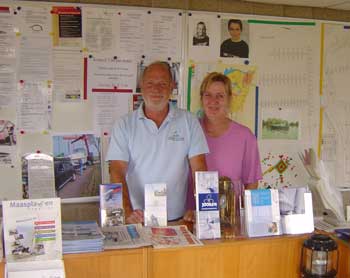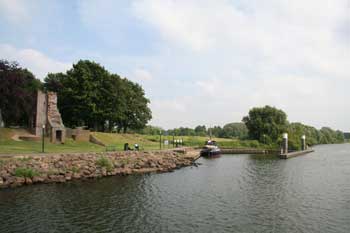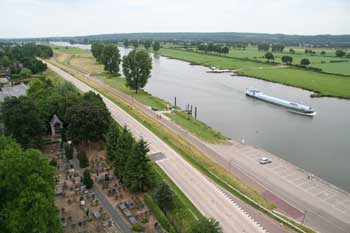Stevensweert to the Mookerplas
Monday 26th - Tuesday 27th June
 After
a happy week exploring South Limburg and the Maasplassen we waved goodbye
to our friends at Stevensweert and headed north, downstream on the Maas.
We had carefully arranged to have the current with us although in non-flood
conditions this only amounts to about 1 knot so is not too much of a concern.
As we had already visited Roermond we opted against the longer winding
loop which passes through the city and took the short-cut Lateralkanaal
Linne-Buggenum. Most of the towns and villages along this stretch of the
Maas have free visitors harbours but there are only moderately protected
from the heavy wash of passing barges and most are not suitable for overnight
stops. We made a careful study of each one, as well as the numerous small
yacht harbours which lie in between. Many of these lie in rather unappealing
industrial harbours and are clearly not intended for passing trade.
After
a happy week exploring South Limburg and the Maasplassen we waved goodbye
to our friends at Stevensweert and headed north, downstream on the Maas.
We had carefully arranged to have the current with us although in non-flood
conditions this only amounts to about 1 knot so is not too much of a concern.
As we had already visited Roermond we opted against the longer winding
loop which passes through the city and took the short-cut Lateralkanaal
Linne-Buggenum. Most of the towns and villages along this stretch of the
Maas have free visitors harbours but there are only moderately protected
from the heavy wash of passing barges and most are not suitable for overnight
stops. We made a careful study of each one, as well as the numerous small
yacht harbours which lie in between. Many of these lie in rather unappealing
industrial harbours and are clearly not intended for passing trade.
The harbour at Venlo seemed the most likely possibiity although it is surrounded by high quay walls and the backs of buildings so does not score highly on visual appeal. We wanted to cover some more ground and continued on to Wanssum where we found the yacht club well off the main navigation beyond a container loading depot and some industrial silos. The attractions here seem to be limited to a harbour side supermarket and chinese restaurant.
 We
did not require the services of either so next morning we were on our
way again and continued our research with a stop at the Paesplas near
Gennep (bargain hunters please note; cheap fuel). This leafy harbour lies
in a former gravel pit, although some 1970's landfill has left less water
than was originally excavated, making it rather more exclusive than some
of the larger lakes to the south. The helpful harbour master had little
English but a good stock of leaflets and duly informed we continued on
our way.
We
did not require the services of either so next morning we were on our
way again and continued our research with a stop at the Paesplas near
Gennep (bargain hunters please note; cheap fuel). This leafy harbour lies
in a former gravel pit, although some 1970's landfill has left less water
than was originally excavated, making it rather more exclusive than some
of the larger lakes to the south. The helpful harbour master had little
English but a good stock of leaflets and duly informed we continued on
our way.
Our next stop was at Cuijk where their visitors harbour again specifies no overnight moorings. Small boats were taking up all the space so we moored on the outside of the harbour wall, calculating that the surging was not normally any less in the confined basin than on the outside wall. After a couple of test barges we concluded it safe to leave the boat and went for a visit to the Museum Ceuclum. Housed in a 14th century church tower you can see Roman finds excavated from the adjacent river as well as enjoy the view from the top of the tower. The 4th century Roman settlement was the location of the only Maas river crossing and controlled the through route to Nijmegen with its imposing castle fort.
 Our
final stop for the day was in the Mookerplas, the most northerly of the
Limburg lakes, lying next to an ice-age ridge which is all of 60m high!
The harbours are surrounded by forestry commission land and offer a secluded
lakeside location which are a favourite for Nordic walkers, joggers and
cyclists.
Our
final stop for the day was in the Mookerplas, the most northerly of the
Limburg lakes, lying next to an ice-age ridge which is all of 60m high!
The harbours are surrounded by forestry commission land and offer a secluded
lakeside location which are a favourite for Nordic walkers, joggers and
cyclists.
Cruising Statistics
Distance (inland): 57 nm
Total to date: 626 nm
Avg Speed: 5.7 kn
Duration: 10 hrs
Diesel: 60 ltrs
Mooring: €15/night at Wanssum; €13/night at Driesen
Electricity:
Included
Water:
Included
Charts
ANWB K Grote Rivieren (electronic)
Toeristische Vaargids van Maas en Schelde
Locks
Sluis Heel
Sluis Belfeld
Sluis Sambeek
Bridges
9 fixed (min 5.7 m)